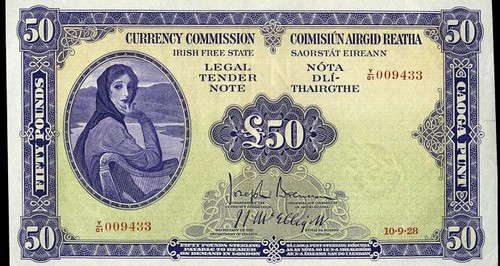
PREV ARTICLE
NEXT ARTICLE
FULL ISSUE
PREV FULL ISSUE
THE “LADY LAVERY” IRISH FREE STATE £50 BANKNOTE
Dix Noonan Webb were mentioned in an article in The Irish Times this week about a rare Irish banknote coming up for sale in their
auction tomorrow. -Editor

An old “Lady Lavery” Irish Free State £50 banknote is expected to sell for up to 360 times its face value at auction in London on Monday. Auctioneers Dix Noonan Webb’s specialist auction of paper money at the saleroom in Bolton Street, central London, includes “a rare 1928 Irish £50 note – one of only about 20 surviving examples available to collectors” which is expected to sell for up to £18,000 (€22,800). Following the establishment of the Irish Free State in 1922, a Currency Commission was set up to advise the government on a monetary system for the new country. The first series of banknotes for the Irish Free State was issued on September 10th, 1928. They were issued in denominations of 10 shillings, £1, £5, £10, £20, £50, and £100, in the colours orange, green brown, blue, red, mauve and olive respectively. The renowned Irish portrait painter Sir John Lavery was commissioned to produce an image of the female personification of Ireland for the banknotes and he used his wife, Lady Hazel Lavery, as his model. Her image appeared on the front of all the notes. The reverse of each note featured an image of a stone river mask of a god representing one of the major Irish rivers based on the sculptures on the facade of Dublin’s Custom House. The mask used on the reverse of the £50 note was that representing the Shannon. The notes were much loved and remained in circulation until the 1970s when new designs were introduced and Lady Lavery was replaced – on the £50 note by Turlough O’Carolan, the blind harpist and composer. Lady Lavery’s image survived as a paper watermark – until she was banished forever with the introduction of new euro notes in 2002. The auctioneers say the 1928 Lady Lavery £50 note was “the most difficult of the series to find”. Although some 10,000 of the £50 notes were printed only “approximately 20 are thought to have survived outside public collections” and the example to be sold “is in unusually good condition. To read the complete article, see:
Wayne Homren, Editor The Numismatic Bibliomania Society is a non-profit organization promoting numismatic literature. See our web site at coinbooks.org. To submit items for publication in The E-Sylum, write to the Editor at this address: whomren@gmail.com To subscribe go to: https://my.binhost.com/lists/listinfo/esylum All Rights Reserved. NBS Home Page Contact the NBS webmaster 
|